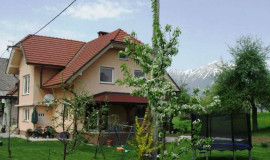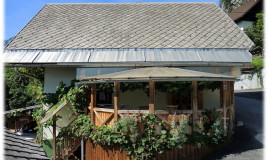
Apartman Valant Bled Slovenia
U mirnom selu u blizini Bleda Bodešče je obiteljska kuća u kojoj možete iznajmiti stan velik 80 četvornih metara. Smješten
Slovenia has only one island but its uniqueness makes it more attractive than many an archipelago. Sheltered by picturesque mountains, the island reigns in the middle of an Alpine lake. Its charm has made it a symbol for centuries of a town to which guests from all over the world love to return. This town, which has already existed for a thousand years, is Bled. If there was a tick sheet of things a tourist or traveller would want from a place based purely on aesthetics, it would probably run something as such; big blue lake, idyllic island, iconic church, domineering castle atop a hill. Lake Bled has all of this, with the added bonus of the church sitting proudly in the middle of the island. It is one of the most popular destinations in Slovenia, and for good reason. Much more than just the iconic castle and island, Bled and the surrounding mountains offer a multitude to see and do.
Bled is one of the 'champions' of Slovene tourism, which attracts crowds of local and foreign tourists. Despite the large number of visitors, Bled still kept its likeability, closeness to the nature and numerous splendid spots that are not overcrowded at all. Lake Bled with its marvelous island and the castle are, of course, a major magnet for visitors. The lake is of glacial-tectonic origins, more than 2 km long and has a good kilometer in width. This is just perfect for a pleasant walk around it and for organizing rowing competitions, which have a long standing tradition in Bled. Between June and September the water is warm enough for bathing and you can swim to the island with no great effort.
A lake, a picture-perfect island with a church, behind the island rises an enormous rock with a castle on top of it and the highest summit of Karavanke mountain chain in the background. That is how we see Bled from the west bank of the lake! Like from a fairytale! The island is, of course, the main attraction of Bled and draws quite a lot of visitors to our tourist gem. It can be reached by a traditional 'pletna' boat, in summer time we can swim to it, and if the winter is cold enough we can even walk to it on ice. A walk around the lake, ascent to the castle or to one of the other viewpoints is wonderful in any weather and in all seasons. Nature has combined and interwoven great natural riches in this small piece of Europe and granted Slovenia extraordinary variety and diversity that is still well preserved today. Over a third of the country's territory lies within the Europe-wide network of Natura 2000 protected areas, while other valuable areas have been proclaimed major parks and reserves. Direct contact with nature is possible even on the edges of cities. As picturesque as a destination can be, Bled is one of the most striking Alpine resorts going and offers something for all manner of visitors, be they old, young, those in search of activity or in search of relaxation.
Classical concerts take place in July and folk music artists come to town in August. The height of festival season is when Bled Days are held. This local late-July celebration has carnival attractions, concerts, costumes and fireworks displays. lake, a picture-perfect island with a church, behind the island rises an enormous rock with a castle on top of it and the highest summit of Karavanke mountain chain in the background. That is how we see Bled from the west bank of the lake! Like from a fairytale! The island is, of course, the main attraction of Bled and draws quite a lot of visitors to our tourist gem. It can be reached by a traditional 'pletna' boat, in summer time we can swim to it, and if the winter is cold enough we can even walk to it on ice. A walk around the lake, ascent to the castle or to one of the other viewpoints is wonderful in any weather and in all seasons.
Nature has combined and interwoven great natural riches in this small piece of Europe and granted Slovenia extraordinary variety and diversity that is still well preserved today. Over a third of the country's territory lies within the Europe-wide network of Natura 2000 protected areas, while other valuable areas have been proclaimed major parks and reserves. Direct contact with nature is possible even on the edges of cities. As picturesque as a destination can be, Bled is one of the most striking Alpine resorts going and offers something for all manner of visitors, be they old, young, those in search of activity or in search of relaxation. Midsummer is a great time to visit Bled. Classical concerts take place in July and folk music artists come to town in August. The height of festival season is when Bled Days are held. This local late-July celebration has carnival attractions, concerts, costumes and fireworks displays.
Independent since 1991, Slovenia does not have a majestic history like many larger European nations, but the past is nevertheless important. For many it is surprising that such a small nation, without kings or famous military leaders of its own, could even form, survive and carve out an independent path. But this is the result of the resilience and determination of the Slovene people, whose culture and common language have survived for centuries in this green piece of Europe. The fertile land and the protective shelter of castle hill and the island, have always invited settlement around the Bled area. The first, and rare traces of humans in Bled, date back to the Stone Age. In the Iron Age, when the mining of iron had begun in the Alpine regions, settlement increased. Beneath the layer of an already discovered Slavic necropolis at Pristava pod Gradom, archaeologists discovered 80 gravesites from the late Iron Age (800 to 600 BC) - Celtic and Roman finds however, are more modest. Bled was later well populated by the Slavs, who arrived in two waves. The Slavic settlements were most probably located at exactly the same spots where the lakeside villages of Mlino, Želeče, Zagorice, Grad and Rečica formed in the late Middle Ages.
A number of gravesites are well known: Žale - the site of a modern day cemetery (archeologically excavated in 1894), the park at the current Vila Bled (1929), the necropolis in Želeče (1937), the large necropolis at Pristava pod Gradom (1948 to 1951), the gravesites next to the current parking area below the entrance to the castle (1960, 1968) and the necropolis on Bled island (1962 to 1966).ndependent since 1991, Slovenia does not have a majestic history like many larger European nations, but the past is nevertheless important. For many it is surprising that such a small nation, without kings or famous military leaders of its own, could even form, survive and carve out an independent path. But this is the result of the resilience and determination of the Slovene people, whose culture and common language have survived for centuries in this green piece of Europe.
The fertile land and the protective shelter of castle hill and the island, have always invited settlement around the Bled area. The first, and rare traces of humans in Bled, date back to the Stone Age. In the Iron Age, when the mining of iron had begun in the Alpine regions, settlement increased. Beneath the layer of an already discovered Slavic necropolis at Pristava pod Gradom, archaeologists discovered 80 gravesites from the late Iron Age (800 to 600 BC) - Celtic and Roman finds however, are more modest. Bled was later well populated by the Slavs, who arrived in two waves. The Slavic settlements were most probably located at exactly the same spots where the lakeside villages of Mlino, Želeče, Zagorice, Grad and Rečica formed in the late Middle Ages. A number of gravesites are well known: Žale - the site of a modern day cemetery (archeologically excavated in 1894), the park at the current Vila Bled (1929), the necropolis in Želeče (1937), the large necropolis at Pristava pod Gradom (1948 to 1951), the gravesites next to the current parking area below the entrance to the castle (1960, 1968) and the necropolis on Bled island (1962 to 1966).
Though the nightlife here is not as vibrant as in some other cities, there are still plenty of things to do at night in Bled. As well as a selection of pubs, you’ll find cocktail bars and a casino. Cesta Svobode is a good street to check out if you’re looking for a bar, and there are also places along Ljubljanska, including inside the shopping centre. The town hosts many different festivals throughout the year. The most popular of these is the Bled Days, taking place each year around the 4th of July weekend. With its concerts, fireworks and floating lights on the lake, this festival attracts the attention of many visitors. One of Bled's top party places, with a large selection of mixed drinks and cocktails and DJs most nights, it attracts a varied mix of tourists, students and local party animals. There's also a big screen TV that more often than not is tuned to some live sporting event, and if you manage to stop by in the morning for a glass of your preferred hang over remedy you can enjoy nice views of the castle and free wireless internet.
.

U mirnom selu u blizini Bleda Bodešče je obiteljska kuća u kojoj možete iznajmiti stan velik 80 četvornih metara. Smješten
 5% Discount
5% Discount
Apartmani Torkar nalaze se u nezagađenom krajoliku Bohinjske Bele, samo 3 km jugoistočno od prekrasnog Bledskog jezera. Naša kuća nalazi